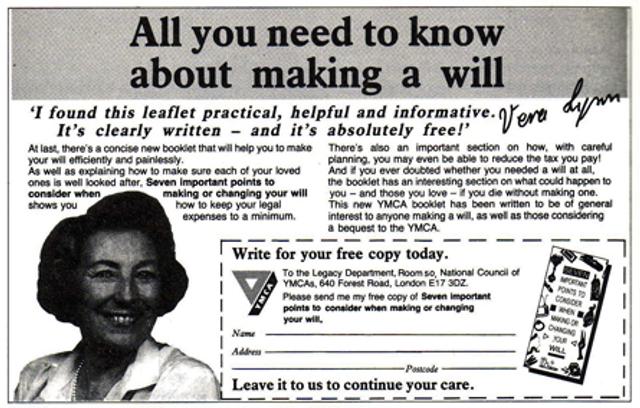YMCA: ‘soft sell’ legacy advertising
- Exhibited by
- Maxine Delahunty.
- Added
- June 20, 2010
- Medium of Communication
- Press advertising
- Target Audience
- Legacy
- Type of Charity
- Children, youth and family
- Country of Origin
- UK
- Date of first appearance
- Unknown
SOFII’s view
Around the same time as WWF was pioneering its new approach to legacy promotion, the Young Men’s Christian Association (YMCA) was also promoting its own version of a legacy information and support service, through a series of press advertisements featuring the wartime songbird Dame Vera Lynn, a personality with a guaranteed appeal to the generation being targeted. While we can’t be sure which of these initiatives appeared first, it is clear that they led the way for a generation of fundraisers to experiment with a new form of ‘soft sell’ legacy promotion.
To see the WWF version of this approach click here.
Creator / originator
Mike Adams at YMCA working with Burnett Associates Limited.
Summary / objectives
YMCA decided to offer a free legacy information service to all comers in the belief that this would generate a useful list of potential prospects all of whom had demonstrated their interest in making, or changing, their will. The new approach called for an ongoing two-pronged communication. First, to encourage as many people as possible to make or change their will. Second, to develop the list of people who had benefited from a charity’s free information service to the point that they might consider including a specific bequest to the cause that had helped them.
Background
This was a new approach, quite radical at the time but with a truly huge potential prize. British charities already get more than one third of all their voluntary income from bequests that come from just eight per cent of the total British population. The potential to increase this is obviously considerable.
At the time clear evidence had emerged showing that a high proportion of the British public had not made a will. The belief was that if more people would make a will, more charities would benefit from charitable bequests. There was a strong current of opinion among fundraisers at the time that legacies could be promoted. However it was felt that a new approach was needed to enable fundraisers to more easily raise the subject with donors and make it possible to develop a dialogue that would lead donors to consider a legacy or bequest in their will, and see this as one of the best ways through which they could help a favoured cause.
Special characteristics
Initially these campaigns were characterised by celebrity led press advertising to build the list. This is a very soft sell and long-term approach, with no easy straight line between marketing message and sale. Jokingly, legacy officers would often remark that, inconveniently, donors don’t die when you want them to. Jest, obviously, but the observation holds more than a smidge of truth, which is perhaps just one reason why this is such a challenging and difficult area for fundraisers.
Influence / impact
Many charities readily copied this approach.
Results
Responses were in the tens of thousands. It proved a bit harder to actually identify which respondents later went on to leave a legacy to the charity. Though some charities were better at recording and analysing results long term than others and a few reckoned they could show a direct result of legacies received from this method of promotion within three years.
Merits
This is one of the leaders in a significant attempt to promote the concept of the charitable bequest, something that in the long run benefits all charities.

Also in Categories
Tags
- Legacy

















